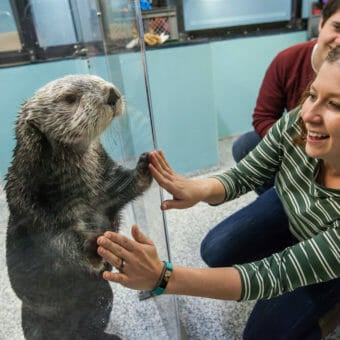-
Size
4 inches (10 cm) -
Diet
Brown and red algae, kelp, and decaying plant and animal matter -
Range
Eastern Pacific Ocean -
Habitat
Rocky shores from the low-tide line
Physical Characteristics
- The purple sea urchin is spiny and ovoid-shaped. Its upper surface is domed and the underside is flattened.
- The mouth has a complex structure made up of five calcium carbonate plates. It is referred to as “Aristotle’s lantern” because he was the first to describe it.
- This sea urchin grows from a greenish-colored juvenile to a vivid purple adult.
- It can grow to 4 inches (10 cm) wide and almost 2 inches (5 cm) tall.
Diet / Feeding
- Purple sea urchins eat brown and red algae, kelp, and decaying plant and animal matter. They grasp food using their spines and tube feet.
Range / Habitat
- Occurs along the coast of the Eastern Pacific from British Columbia to Baja California.
- Found on rocky shores from the low-tide line to depths of 525 feet (160 m).
Reproduction & Growth
- Oviparous (egg-laying species); gametes spawn in the water column.
Conservation Status
- “Not Evaluated” on the IUCN Red List.
Additional Information
- Purple sea urchin moves on small tube feet, which are found all over the animal. Each tube foot can be extended or contracted and each terminates in a tiny suction cup which allows it to cling to hard surfaces.
- This urchin can tolerate temperatures of 41o to 74oF (5o-23.5oC). Water temperatures above about 79oF (26oC) cause massive die-offs.
- The test (or shell) of the purple sea urchin is actually a hard, thin calcareous skeleton, rather than a shell.
- The genome of S. purpuratus was sequenced in 2006, revealing about 23,300 genes.
- Purple sea urchin can regenerate broken spines and can grow new teeth at rates that result in their complete exchange in about 75 days in the lab.
- Sea urchins are an important part of the diet of sea otters. They also are preyed upon by numerous fish species, such as wolf eels and sheepshead, as well as sea stars.
- Pigment from the urchins’ spines will lodge in the bones of the sea otters and stain them purple.
- Purple sea urchin ovaries are shipped to Japan for sushi (uni).
Sources
- www.animaldiversity.ummz.umich.edu
- www.wallawalla.edu
- Intertidal Invertebrates of California, Morris, Robert H







